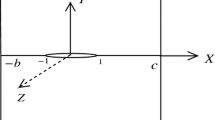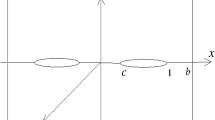Abstract
The focus of this paper is centered on diffraction of P-wave by a Griffith crack in an infinite isotropic elastic medium on which impact load is applied. Suddenly applied equal but opposite normal stresses on crack faces causes the separation of the crack faces. Laplace and Fourier transforms have been employed to convert the problem to a Fredholm integral equation of second kind in the Laplace transform plane which has been solved by perturbation method. Stress intensity factor has been computed numerically by Laplace inversion using Zakian’s algorithm and plotted graphically against time for different isotropic materials.



Similar content being viewed by others
References
Basu, S., Mandal, S.C.: Impact of torsional load on a penny shaped crack in an elastic layer sandwiched between two elastic half-spaces. Int. J. Appl. Comput. Math. 2, 533–543 (2016)
Baksi, A., Das, S., Bera, R.K.: Impact response of a cracked orthotropic medium-revisited. Int. J. Eng. Sci. 41, 2063–2079 (2003)
Chen, E.P., Sih, G.C.: Elastodynamic Crack Problems Mechanics of Fracture, vol. 4. Noordhoff, Leyden (1977)
Chudnovsky, A., Kachanov, M.: Interactions of a crack with a field of microcracks. Int. J. Eng. Sci. 21, 1009–1018 (1983)
Dhaliwal, R.S.: Two coplanar cracks in an infinitely long orthotropic elastic strip. Util. Math. 4(16), 115–128 (1973)
Das, S., Patra, B., Debnath, L.: Stress intensity factors for an interfacial crack between an orthotropic half-plane bonded to a dissimilar orthotropic layer with a punch. Comput. Math. Appl. 35, 27–40 (1998)
Das, S.: Elastodynamic response of a cracked orthotropic medium under impact loading. Comput. Mater. Sci. 37, 187–192 (2006)
Das, S., Patra, B., Debnath, L.: Diffraction of SH-waves by a Griffith crack in an infinite transversly orthotropic medium. Appl. Math. Lett. 12, 57–61 (1999)
De, J., Patra, B.: Edge crack in orthotropic elastic half-plane. Indian J. Pure Appl. Math. 20, 923–930 (1989)
Eringen, A.C., Suhubi, E.S.: Elastodynamics, vol. II. Academic press, New York, San Francisco, London (1975)
Freund, B.L.: The stress intensity factor due to normal impact loading of the faces of a crack. Int. J. Eng. Sci. 12, 179–189 (1974)
Irwin, G.R.: Analysis of stresses and strains near the end of a crack traversing a plate. J. Appl. Mech. E24, 351–369 (1957)
Itou, S.: Diffraction of an antiplane shear wave by two coplanar Griffith cracks in an infinite elastic medium. Int. J. Solids Struct. 16, 1147–1153 (1980)
Kassir, M.K., Bandyopadhyay, K.K.: Impact response of a cracked orthotropic medium. J. Appl. Mech. 50, 630–636 (1983)
Kuo, A.Y.: Transient intensity factors of an interfacial crack between two dissimilar anisotropic half-spaces. J. Appl. Mech. 51, 71–76 (1984)
Lira-Vergara, E., Rubio-Gonzalez, C.: Dynamic stress intensity factor of interfacial finite cracks in orthotropic materials. Int. J. Fract. 135, 285–309 (2005)
Lira-Vergara, E., Rubio-Gonzalez, C.: Dynamic response of interfacial finite cracks in orthotropic naterials subjected to concentrated loads. Int. J. Fract. 169, 145–158 (2011)
Mandal, S.C., Ghosh, M.L.: Interaction of elastic waves with a periodic array of coplanar Griffith cracks in an orthotropic medium. Int. J. Eng. Sci. 32, 167–178 (1994)
Marin, M.: A temporally evolutionary equation in elasticity of micropolar bodies with voids. U.P.B. Sci. Bull. Ser. A Appl. Math. Phys. 60, 3–12 (1998)
Marin, M., Stan, G.: Weak solutions in elasticity of dipolar bodies with stretch. Carpathian J. Math. 29(1), 33–40 (2013)
Marin, M.: On vibrations in thermoelasticity without energy dissipation for micropolar bodies. Bound. Value Probl. 111, 1–19 (2016)
Mishra, H.K., Nagar, A.K.: He-Laplace method for linear and non-linear partial differential equations. J. Appl. Math. 2012, 1–16 (2012)
Rubio-Gonzalez, C., Mason, J.: Response of finite crack in orthotropic materials due to concentrated impact shear loads. J. Appl. Mech. 66(2), 485–491 (1999)
Rubio-Gonzalez, C., Mason, J.: Elastodynamic analysis of the finite punch and finite crack crack problems in orthotropic materials. Int. J. Fract. 112, 355–378 (2001)
Rice, R.G., Do, D.D.: Applied Mathematics and Modeling for Chemical Engineers. Wiley, New York (1995)
Satpathy, P.K., Parhi, H.: Stress in an orthotropic strip containing a Griffith crack. Int. J. Eng. Sci. 16, 147–154 (1978)
Sarkar, J., Mandal, S.C., Ghosh, M.L.: Diffraction of elastic waves by three coplanar Griffith cracks in an orthotropic medium. Int. J. Eng. Sci. 33, 163–177 (1995)
Shul, C.W., Lee, K.Y.: Dynamic response of subsurface interface crack in multi-layered orthotropic half-space under anti plane shear impact loading. Int. J. Solids Struct. 38, 3563–3574 (2001)
Srivastava, K.N., Palaiya, R.M., Karaulia, D.S.: Interaction of antiplane shear waves by a Griffith crack at the interface of two bonded dissimilar elastic half spaces. Int. J. Fract. 16, 349–358 (1980)
Acknowledgements
This research work is financially supported by the CSIR , New Delhi, India.
Author information
Authors and Affiliations
Corresponding author
Appendix
Appendix
In this algorithm f(t) is computed as a sum of weighted evaluations of F(p).
where the values of \(K_i, p_i\) and N are dictated by a particular method. The development of Zakian’s algorithm is given in Rice et al. [25]. The time function can be related to a finite series of exponential functions
The significance of this specification is that Zakian’s algorithm is very accurate for over-damped and slightly under-damped systems. But it is not accurate for systems with prolonged oscillations.
Given F(p) and a value of time t, the following equations implements Zakian’s algorithm and allows us to calculate the numerical value of f(t).
Table 1 gives the set of five complex constants for \(\alpha _i\) and \(K_i\).
Zakian’s algorithm is simple to implement and computes quickly. But note that the initial value of f(t) at \(t=0\), cannot be computed. Also, when there are oscillatory systems, f(t) becomes inaccurate after approximately the second cycle.
Rights and permissions
About this article
Cite this article
Naskar, S., Mandal, S.C. P-wave Diffraction by a Crack Under Impact Load. Int. J. Appl. Comput. Math 4, 109 (2018). https://doi.org/10.1007/s40819-018-0540-8
Published:
DOI: https://doi.org/10.1007/s40819-018-0540-8




